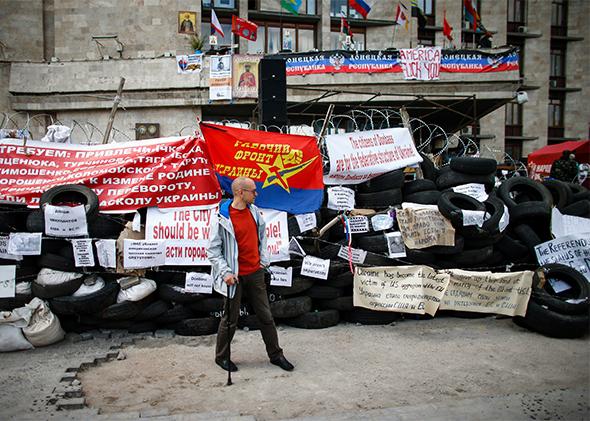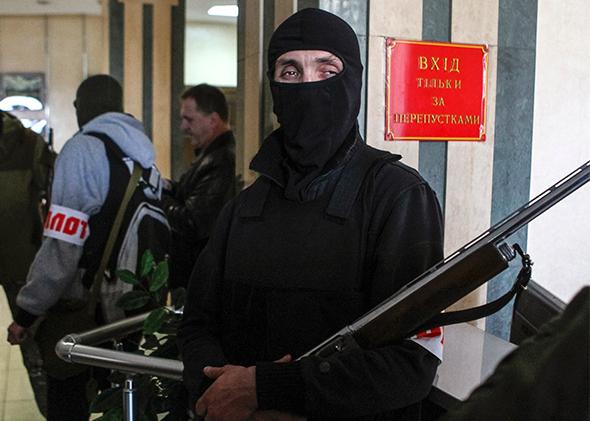WARSAW, Poland—In the Western imagination, the words “war” and “invasion” carry clear connotations. From books, movies, and television, we know that such events involve tanks, airplanes, and artillery, as well as soldiers in uniform, advanced weaponry, and sophisticated communications. They look like the invasion of Iraq or, to go back in time, D-Day.
So far, the Russian invasion of eastern Ukraine looks nothing like these battles. This war involves not soldiers but local thugs and volunteers, some linked to the ex-president, Viktor Yanukovych, some from criminal gangs, and some who mistakenly think they are fighting for some form of benign local autonomy.
They are being led not by officers in uniform but by men from Russian military intelligence and special operations forces, some wearing camouflage without insignia, some communicating with “activists” by telephone. They are supplied with Russian logistics and a few Russian automatic weapons, but not tanks or planes. There is no “shock and awe” bombing campaign, just systematic, organized attacks on police stations, city councils, airports.
Unlike the planners of D-Day or Operation Iraqi Freedom, the Russians organizing the invasion of Ukraine also have flexible goals. They are prepared to adjust their strategy, depending on how much resistance they encounter. In the long term, Russia clearly hopes to annex eastern and southern Ukraine; maps to that effect have begun to circulate.
But in the meantime, the Kremlin may settle for disrupting Ukraine’s presidential elections, scheduled for May 25, or for destabilizing Ukraine’s shaky provisional government, perhaps forcing an economic crash. The Russians may hope to provoke a civil war, or something that appears to be a civil war, which would then require a Russian “peacekeeping mission.”
Many of these tactics are familiar, though we haven’t seen them for a long time. In 1945, Soviet secret policemen, given the task of transforming disparate Eastern European nations into communist puppet states, also began by organizing local thugs and volunteers—criminals, war-damaged sociopaths, as well as people who mistakenly believed they were fighting for a form of benign socialism—into paramilitary and secret police forces, exactly like the ones operating in eastern Ukraine. Then as now, they led from the shadows. Then as now, they adjusted their strategy depending on how much resistance they encountered and how much support they received.

Photo by Marko Djurica/Reuters
But the 21st century is not the 20th century. When Polish communists, backed by Soviet communists, falsified the results of a national referendum in 1946, there weren’t many international observers around to complain. In the past few days, by contrast, the Internet has lit up with photographs of “pro-Russian activists” carrying Russian-made RPGs, as well as audio clips of Russians barking orders. The effect of these revelations, however, has been to encourage the Russians to lie more brazenly and aggressively. The Russian foreign minister continues to insist that Moscow is not interested in destabilizing Ukraine, and Vladimir Putin has called on the U.N. to condemn Ukraine’s weak and confused attempts to defend itself. Russian television—watched by many in eastern Ukraine—continues to denounce nonexistent violence coming from “fascist Kiev” and is even showing politicized weather reports: Dark clouds are gathering over Donetsk while there is sun in Crimea. These language games and disinformation campaigns are now far more sophisticated than anything the Soviet Union ever produced.
This combination—old-fashioned Sovietization plus slick modern media—is genuinely new, so much so that it’s fair to say we are witnessing a new kind of war, and a new kind of invasion. Thirteen years ago, in the wake of 9/11, the United States suddenly had to readjust its thinking to asymmetric warfare, the kinds of battles that tiny groups of terrorists can fight against superior military powers. We relearned the tactics of counterinsurgency in Iraq.
But now Europe, the United States, and above all the Ukrainians need to learn to cope with masked warfare—the Russian term is maskirovka—which is designed to confuse not just opponents, but the opponents’ potential allies. As I’ve written, the West urgently needs to rethink its military, energy, and financial strategies toward Russia. But more specific new policies will also be needed to fight the masked invasions that may follow in Moldova or, in time, the Baltic states if this one succeeds.
Americans and Europeans should begin now to rethink the funding and the governance of our international broadcasters in order to counter the new war of words. We should also begin now to reinforce the local police forces of the states that border the new Russian empire: NATO’s F-16s cannot fight thugs who are storming the town hall. This isn’t just about spending money: We need more special operations forces, more “human” intelligence, not just more ships and planes. Above all we need to be prepared, in advance, for what may come. It’s a new world we are now entering, and we need new tools to cope with it.
